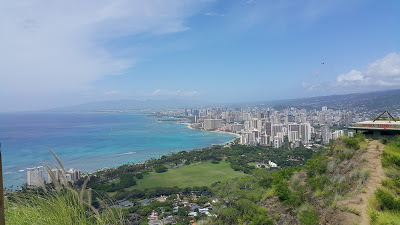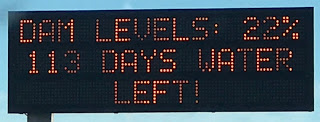or: Droughts and long showers are incompatible
One of my worst acts of environmental waste is due to my fondness of long showers. Aside from getting clean, it has many other benefits, including relaxation (I seem to find the whole process quite meditative) as well as it being a great thinking spot. There’s a plus side for everyone else too – it’s one of the few places I sing, but that’s another story.
I have been known to tell people I left Australia due to the drought and my love of long showers. It was a community service. With over 17 reservoirs, HK seemed like a logical place to relocate for a long shower lover. They are currently at 67% capacity which is 1% down on this time last year.
I have been under a massive misconception…
First, some history – don’t be freaked out by that word, it gives context
Around 1841, bamboo aqueducts moved the water from streams to villages with only four wells built over the next 11 years. With the population growing a little more quickly than expected, Pok Fu Lam Reservoir was built in the 1860s. It wasn’t enough, particularly through winter which is pretty dry in HK. So the engineers went back to work to expand it and this was completed by 1877. Still not enough.
This is when the Tai Tam Reservoir was built. It’s massive. It’s also a great place to walk around and take photos but I’m fairly sure that’s not what they had in mind when building it. It’s different to the Pok Fu Lam Reservoir as it doesn’t rely on gravity and needs pumps instead.
More reservoirs were then built on Kowloon side when it was leased to Britain. Then a few more on HK side. Pipes were laid across the Harbour to transfer water and metered water in housing increased in popularity. Water though was still fairly intermittent due to the weather. This was highlighted in 1929 when there was a massive drought which led to water being imported from China and Japan. There was another drought in 1963-1964 and this one had people fighting at water pumps. At about the same time, Plover Cove Reservoir was under construction and finished in 1978. It has some unique features too but this isn’t meant to be a post about impressive reservoirs…
In a country which is not yet known for environmentally-friendly initiatives, all this catchment and reservoir building led to planting forests in areas now designated as not able to be developed as it would impact the water. It helps to explain why over 70% of HK is national park. The irony is the trees planted are not native to HK and their leaf litter isn’t so good for the streams as it takes a longer time to decompose. There’s been work happening for quite a while on changing the make-up of some of these areas.
Back to the environmental aspect… I had no idea I had been flushing my toilet with sea water for all those years. No, this isn’t a euphemism for the fact that the source of 70-80% of HK’s water is actually Dongjiang (East River) in Guandong rather than the HK reservoirs. It really is sea water in the toilet. And yes, the Dongjiang water goes through a treatment plant before it hits the HK taps. The World Health Organisation is very happy with the quality of HK’s water.
So what does this all mean?
It means that HK is paying to import a large chunk of its water. I’ve been having long showers with expensive imported water.
And now…
I’m in Cape Town. After two years of the least rainfall on record, it’s in drought and under Level 3B water restrictions since 1 February 2017. It means dam levels are critically low and residences need to find 30% water savings since 75% of water consumption occurs at home. During this time, the cost of water increases too.
Four years ago, the dams were twice as full as they are now.
Gardens can be watered on Tuesdays and Saturdays before 9am or after 6pm for a maximum of one hour however many are opting to have their showers with buckets in it and wash their hands over other buckets to then use this grey water more frequently. Similar to Australians, Cape Townians like a good lawn and garden.
No hosing the driveway or other hard surfaces either (I’ve always been surprised that people would do this but I guess that’s because I haven’t seen it done since before the last droughts in Australia, isn’t that why hard-bristled brooms were invented?).
It is at the stage where people take pride in having a dirty car. Or they bucket wash it or go to a commercial car cleaner which has other restrictions in place.
The thing that is really interesting is residences are being named and shamed for using excessive water. It’s kept the 4 million residents on their toes and in conversations I’ve heard, people are becoming a bit competitive about the size of their water bills and how much they’ve reduced their consumption.
Ahhh that takes me back…
I like how there are roadsigns around the place advising the current level too. It’s good to keep it all top of mind.
Dams are currently at 30% capacity but the last 10% doesn’t really count as it can’t be extracted. There’s 100 days of drinking water and no long showers left as of this post. They think this should be enough to last until the rainy season. It needs to really rain in rainy season this time.
It’s so bad that in early March the mayor of Cape Town declared the drought for city a local disaster. This gives more resources to being able to manage the drought.
It rained on Wednesday and while it temporarily cleaned cars, it did little to fill the dams.
Living a considerable amount of my life in the world’s driest inhabited continent, I am no stranger to water restrictions. I’ve adjusted my showering and reduced the frequency of washing my hair so I can be even faster. My thinking time now seems to occur when I’m asleep. The timing is lousy.
Australians are very familiar with drought conditions and the country itself has considerably improved water management since the Millennium Drought. Droughts are so big in Australia, they have their own names… To be fair, that drought is still considered the worst since European settlement. It lasted from 1997 to 2010.
Prior to this and definitely since, each state has been working hard to drought proof their water supplies and they are each tackling this in their own way. Some of the approaches Australia took have now been used in other areas too as they were shown to be quite effective.
Since the last big drought in Sydney, water-wise habits that were picked up then means average water bills are down AUD100 / year. Water usage has decreased from 415.6 litres / person / day to 293.4 in 2016. Some of this may be because I left the country…
It’s also due to the increased use of water saving devices on taps, less wasteful washing machines, changing toilets, the use of rainwater tanks and hard-bristled brooms being used on driveways etc.
In the meantime, I’ve been thinking about when I can next have a slightly longer shower. I’m not going to go all out and back to my former length. Just a bit longer than my current ones. Perhaps one where I can wash my hair two days in a row after doing some physical activity.
It doesn’t look like it will be any time soon though as my next few stops also seem to be in drought impacted areas and another only has cold sea water showers.
I will need to find another time and place to think. And sing…
Further reading if you’re interested
Why HK Shouldn’t Take Clean Plentiful Water for Granted
Water Does Not Come Cheap
Drinking Water Quality in HK
This Week’s Dam Levels in Cape Town
With Just 100 Days of Water Left, Cape Town Risks Running Dry
* Thanks to Nick Cave & the Bad Seeds for the title to this post. They have a best of album coming out on 5 May called Lovely Creatures. Songs from 1884-2014 and you can preorder from their website.


